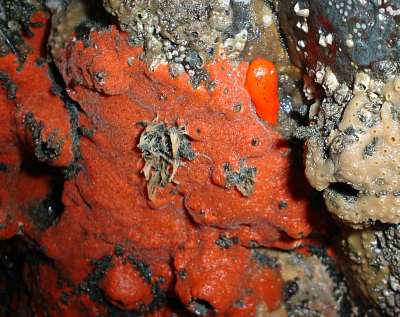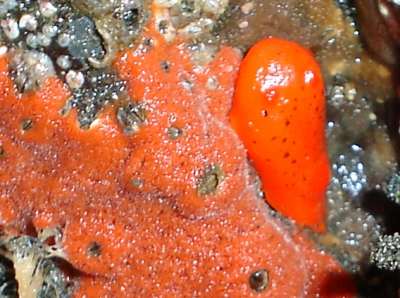Rostanga pulchra or Aldisa cooperi?
March 30, 2006
From: Minette Layne

I'm wondering if you can help me to identify this nudibranch.
When I took this photograph, I assumed that the red nudibranch was Rostanga pulchra. It seemed a bit out of the ordinary to me, because of its rather large size (approximately 1") and because of the little black speckles along its back, but a little bit of reading (in David Behren's "Pacific Coast Nudibranchs") turned up a reference to Rostanga of that size and with those markings, so I considered it a positive ID.
I keep coming back to the picture, however, and wonder if the nudibranch in question isn't Aldisa cooperi instead of Rostanga pulchra.
Locality: Sooke, Intertidal, British Columbia, Canada, Strait of Juan de Fuca, June 2005, In a small sea cave. Length: 1". Photographer: Minette Layne.
The picture quality is so poor that it might be impossible to make a definitive ID, but I'm curious if you or one of the other participants on the forum can see something obvious about this critter that can help me identify it with more certainty.
Minette Layne
minette_layne@hotmail.com
Layne, Minette, 2006 (Mar 30) Rostanga pulchra or Aldisa cooperi?. [Message in] Sea Slug Forum. Australian Museum, Sydney. Available from http://www.seaslugforum.net/find/16174
Dear Minette,
The identification of individuals out of the water is always challenging. All the characteristics are laying limp. My guess however is that your critter is Rostanga pulchra, because of the scattered spots. Incidentally, Sooke (pronounced - ta-suck by the native people) is one of my favorite places on this coast.
Now I need to put the work back on your shoulders -- hopefully you can return to the red sponge. Your critter will likely still be there. Rostanga has very unique rhinophores, see the drawing in my book. The rhinophores of Aldisa are perfoliate, like most dorids.
Also, the dorsal surface of Rostanga is covered with numerous small papillae with spicules protruding (caryophyllidia). The dorsal surface of Aldisa has low tubercles.
Get your animal underwater - in a dish - and check out these features. Good luck.
Best wishes,
Dave Behrens
Related messages
-
Re: Rostanga pulchra from Vancouver Island
From: Jeff Goddard, August 28, 2008 -
Re: Rostanga pulchra from Vancouver Island
From: Jackie Hildering, July 30, 2008 -
Rostanga pulchra from La Jolla, California
From: Kevin Lee, July 31, 2007 -
Rostanga pulchra from Point Lobos, California
From: Clinton Bauder, July 23, 2007 -
Re: Aldisa cooperi? from British Columbia
From: Jackie Hildering, July 11, 2007 -
Spotted Rostanga pulchra from Point Lobos, CA
From: Clinton Bauder, February 7, 2007 -
Rostanga pulchra from Vancouver Island
From: Minette Layne, March 22, 2006 -
Rostanga pulchra from Carmel, CA
From: Clinton Bauder, November 21, 2005 -
Rostanga pulchra from San Juan Islands
From: Paul Sim, September 19, 2005 -
Re: Food of Rostanga pulchra
From: Cynthia Trowbridge, August 8, 2002 -
Food of Rostanga pulchra
From: Brian Penney , August 7, 2002 -
Rostanga pulchra from Carmel, CA
From: Clinton Bauder, February 14, 2002 -
Rostanga pulchra from Vancouver Island
From: Bill Rudman, February 4, 2002 -
Re: Rostanga pulchra or Aldisa cooperi?
From: Clinton Bauder, April 12, 2000
